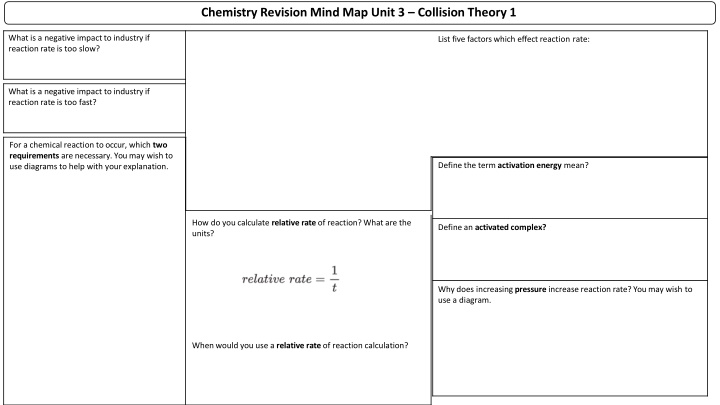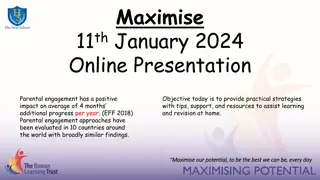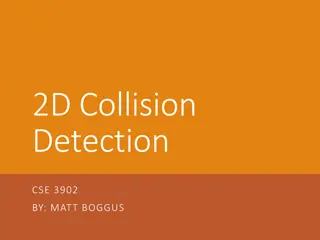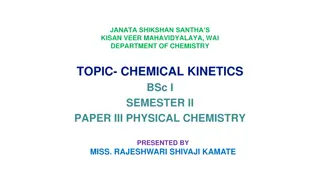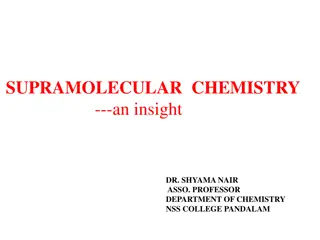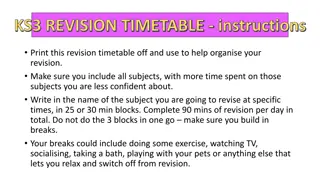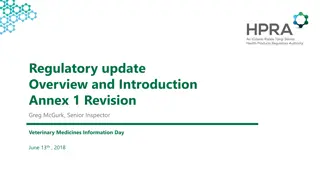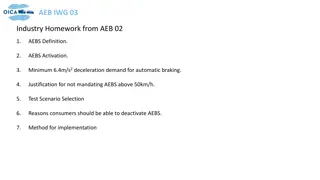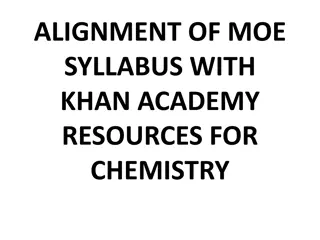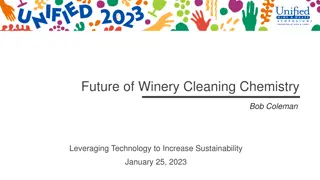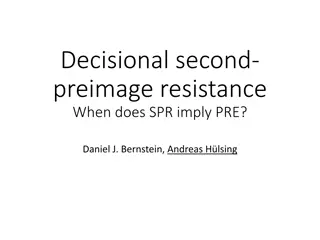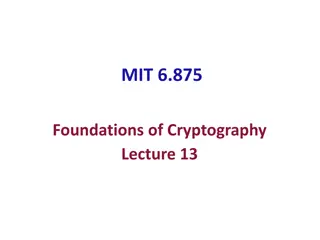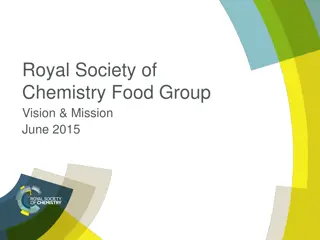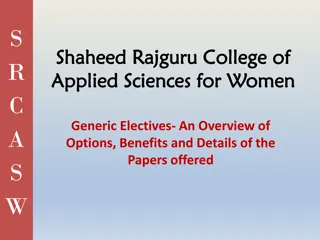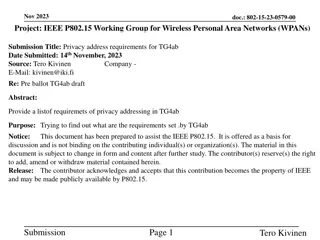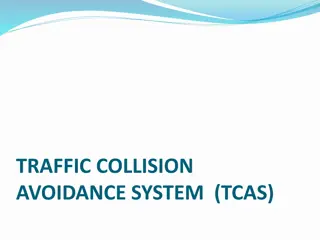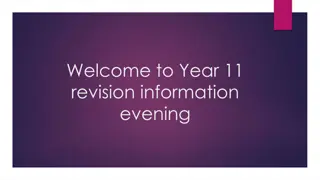Chemistry Revision: Collision Theory Impacts and Factors
Negative impacts of slow and fast reaction rates on industry, the factors affecting reaction rate, requirements for chemical reactions, activation energy, relative rate calculation, activated complex, pressure effects, catalyst roles, and temperature impacts on reaction rate.
Download Presentation

Please find below an Image/Link to download the presentation.
The content on the website is provided AS IS for your information and personal use only. It may not be sold, licensed, or shared on other websites without obtaining consent from the author.If you encounter any issues during the download, it is possible that the publisher has removed the file from their server.
You are allowed to download the files provided on this website for personal or commercial use, subject to the condition that they are used lawfully. All files are the property of their respective owners.
The content on the website is provided AS IS for your information and personal use only. It may not be sold, licensed, or shared on other websites without obtaining consent from the author.
E N D
Presentation Transcript
Chemistry Revision Mind Map Unit 3 Collision Theory 1 What is a negative impact to industry if reaction rate is too slow? List five factors which effect reaction rate: What is a negative impact to industry if reaction rate is too fast? For a chemical reaction to occur, which two requirements are necessary. You may wish to use diagrams to help with your explanation. Define the term activation energy mean? How do you calculate relative rate of reaction? What are the units? Define an activated complex? Why does increasing pressure increase reaction rate? You may wish to use a diagram. When would you use a relative rate of reaction calculation?
Chemistry Revision Mind Map Unit 3 Collision Theory 2 State two conditions necessary for collisions to result in the formation of products Use collision theory to explain why decreasing particle size increases reaction rate. Use may wish to use a diagram. Use collision theory to explain why increasing concentration increases reaction rate. You may wish to use a diagram. How does a catalyst increase the rate of a reaction? Is a catalyst used up during a chemical reaction? Does the catalyst provide energy to the reaction?
Chemistry Revision Mind Map Unit 3 Collision Theory and Kinetic energy 3 Use collision theory to explain why increasing temperature increases reaction rate. Use ay wish to use a diagram. Draw an energy distribution diagram and draw a line to show activation energy. Draw an energy distribution diagram and draw a line to show activation energy. On the diagram draw a second curve to show an increase in temperature. On the diagram draw a line to show the effect of adding a catalyst. Explain why a small increase in temperature results in a large increase in reaction rate. Explain why adding a catalyst results in an increase in reaction rate. What is temperature a measure of?
Chemistry Revision Mind Map Unit 3 Collision Theory and Kinetic energy 4 Sketch a graph to show the effect of increasing concentration on relative rate of reaction. Sketch a graph to show the effect of increasing temperature on relative rate of reaction. The straight line shows that rate is directly proportional to concentration. The curved line shows that a small increase in temperature results in a If you double the concentration, you the rate of reaction. increase in rate if reaction.
Chemistry Revision Mind Map Unit 3 Reaction pathways 5 Draw a potential energy diagram to show the energy pathways for an exothermicreaction. How do you calculate enthalpy change ( H) Define an endothermic reaction Is enthalpy change positive or negative for exothermic reactions? Draw a potential energy diagram to show the energy pathways for an exothermic reaction and draw a line to show the addition of acatalyst. Is enthalpy change positive or negative for endothermic reactions? How do you calculate activation energy (Ea)? Draw a potential energy diagram to show the energy pathways for an endothermicreaction. On both potential energy diagrams drawn, annotatethe following: 1. Activated complex 2. Activation energy (Ea) 3. Enthalpy change( H) Explain why the addition of a catalyst increases reactionrate. Define an exothermic reaction What happens to Ea when a catalyst is added? What happens to H when a catalyst isadded?
Chemistry Revision Mind Map Unit 3 Chemical Energy 6 In industry exothermic reactions may require heat to be removed,why? 1g of butan-2-ol was burned and the temperature rose from 12 C to 44 C. Use these results to calculate the enthalpy of combustion of butan-2-ol. Which two products are formed when a hydrocarbon is burned in oxygen. In industry endothermic reactions may cost more, why? One mole of substance is the same as the what of the substance? What is the definition of enthalpyof combustion? The enthalpy of combustion of methanol (CH3OH) is -727 kJ mol-1.. What mass of methanol has to be burned to produce 72.7 kJ of energy? State two improvements to the experiment above and an explanation of the improvement. Why is the below equation not an enthalpyof combustion equation? 2CO + O2 2CO2 Write the equation used to calculate heat energy and specify what each part of the equationis.
Chemistry Revision Mind Map Unit 3 Hesss Law and Bond Enthalpy 7 CS2 (l) + 3O2 (g) CO2 (g) + 2SO2 (g) Which phase must the reactants be in when calculating bond enthalpy? Hess s Lawstates: Calculate the enthalpy change, for this reaction using the followinginformation What is the equation to calculate bond enthalpy? C (s) + O2 (g) CO2(g) S (s) + O2 (g) SO2(g) C (s) + 2S (s) CS2(l) H= -400.4 kJ mol-1 H= -299.6 kJ mol-1 H= 77.8 kJ mol-1 According to Hess s Law, calculate the H value from Y to X. Using bond enthalpies, calculate the enthalpy change for the following reaction + 2H2 (g) Define the molar bond enthalpy Define the mean molar bond enthalpy
Chemistry Revision Mind Map Unit 3 Equilibrium8 At equilibrium, the rates of the forwardand reverse reactionare ______. In the followingequation: Enthalpy change for an exothermic reactionis: 2CO (g) + O2(g) 2CO2(g) At equilibrium, the concentration of reactants andproductsare _____________________ . Enthalpy change for an endothermic reactionis: What effect will the following have on theequilibrium: 1. Increasing pressure?Why? What is Le Chatelier sPrinciple? In the followingequation: 2SO2 (g) + O2 (g) 2SO3(g) H = -197kJ 2. Decreasing pressure? Why? What effect will the following have on theequilibrium: 1. Increasing the temperature?Why? In the followingequation Br2(l) + H2O(l) Br (aq) + BrO (aq) + 2H+(aq) In the followingequation: What effect will the following have on equilibrium: 1. Sulfuric acid was added?Why? 2. Decreasing the temperature?Why? H2 (g) + I2(g) 2HI(g) What effect will the following have on theequilibrium: 1. Increasing pressure? Why? 3. What would you need to do to the temperature to increase the yield of products? 2. Sodium hydroxide was added?Why? 3. Silver nitrate was added?Why? What state does a change in pressure effect?
Chemistry Revision Mind Map Unit 3 Calculations 9 2.45g of magnesium is added to 100 cm3 of dilute hydrochloric acid, concentration 1mol l-1 Identify the limitingreagent. Mg + 2HCl Excess ethyne was reacted with 3.7g of hydrogen chloride and 4.1 g of the product, 1,1-dichloroethane was obtained. Calculate the % yield using theequation: What is molarvolume? @ STP MgCl2 + H2 What volume of hydrogen would be produced if 10g of H2SO4, reacts completely with excess zinc? (molar gas volume is 22.4 litres mol-1) C2H2 + 2HCl C2H4Cl2 Zn(s) + H2SO4(aq) ZnSO4(aq) + H2(g) What does 100% atom economy mean? What mass of oxygen has been used when burning propane, if 3.6 litres of carbon dioxide is produced? (all gases being at the same temperature and pressure, take the molar volume of carbon dioxide to be 22.4l/mol) What is percentage yield? Calculate the atom economy for this reaction where hydrogen is the desiredproduct. CH4 + H2O CO + 3H2 C3H8 (g) + 5O2(g) 3CO2 (g) + 4H2O (l)
Chemistry Revision Mind Map Unit 3 Chemical Analysis 10 How do you make up a standard solution? (3marks) In paper chromatography what isthe: Mobile phase: Stationary phase: In gas chromatography why is a gas such as helium used as the mobile phase? What two factors influence separation by chromatography: The peak in a chromatogram indicateswhat? If the peak is off the scale what does this indicate? Why is an indicatorused? Why is a white tile used? How could you make the peak in scale? Largermoleculesmove ________________ in chromatography. In a redox titration using acidified permanganate, why is an indicatornot required? Rf value = distance of substance/distance travelled by solvent Which pieces of equipment are used foraccurate measurements in chemistry Why is an acidadded? Calculate the concentration of Iron (II) sulfate solution given that 20cm3 of it reacted with 0.02mol l-1 potassium permanganate solution. The average volume of potassium permanganate solution used was 10cm3 The redox equationis: MnO4-+ 8H+ + 5Fe2+ Calculate the Rf Value of spot 3 inthe chromatogram below. What name is given to titres between0.2cm3? 5Fe3+ + Mn2+ + 4H2O Why is the first titre never used when calculating the average titre? What is a standardsolution?
